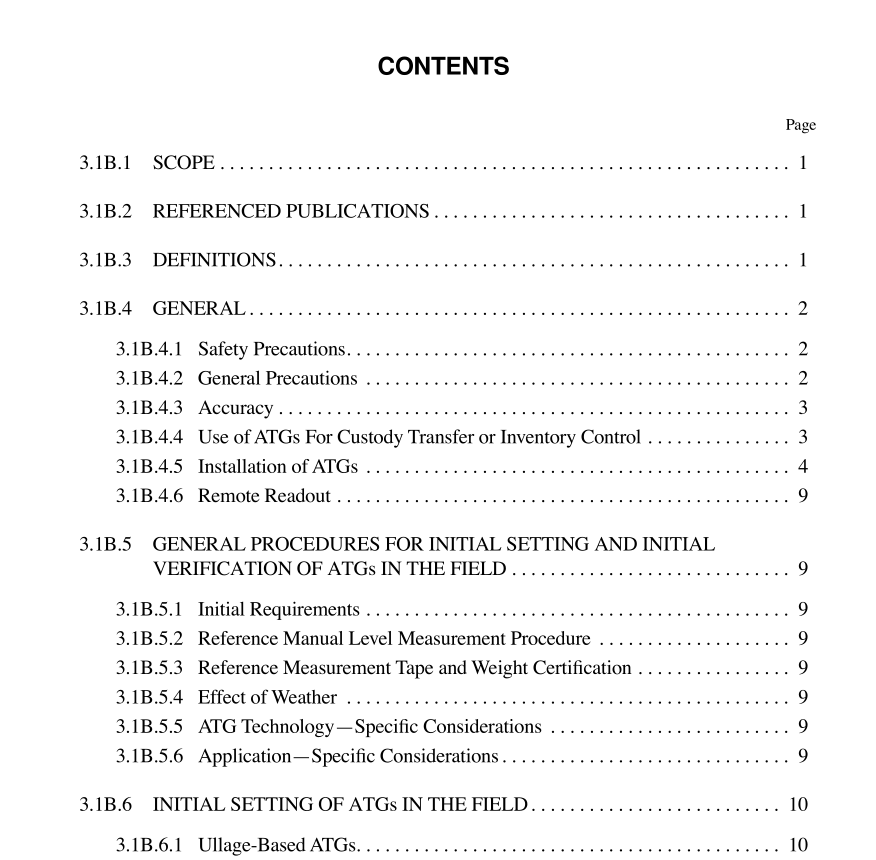API MPMS 3.1B pdf download

API MPMS 3.1B pdf download.Manual of Petroleum Measurement Standards Chapter 3—Tank Gauging
3.1B.1 Scope
This standard covers level measurement of liquid hydro- carbons in stationary, aboveground, atmospheric storage tanks using automatic tank gauges (ATGs). The standard dis- cusses automatic tank gauging in general, accuracy, installa- tion, commissioning, calibration and veriÞcation of ATGs that measure either innage or ullage. It covers both intrusive and non-intrusive ATGs used for either custody transfer or inventory control. The standard also covers the requirements for data collection, transmission and receiving. This standard does not cover the following: a. Hydrocarbons having a Reid vapor pressure above 15 pounds per square inch absolute (100 kPa). b. Measurement of weight or mass with ATG equipment. This is covered in Chapter 3.6 and Chapter 16.2 of the Man- ual of Petroleum Measurement Standards . c. Measurement of level in underground tanks or in pressur- ized tanks storing liquid hydrocarbons. d. Conversion of tank level to liquid volume. This is covered in Chapter 12.1 of the Manual of Petroleum Measurement Standards . e. Measurement of temperature, sampling, density and sedi- ment and water (S & W), which are discussed in Chapters 7Ð 10 of the Manual of Petroleum Measurement Standards . Safety and material compatibility precautions should be taken when using ATG equipment. ManufacturersÕ recom- mendations on the use and installation of the equipment should be followed. Users should comply with all applicable codes and regulations, API Standards and NFPA 70 National Electric Code .
3.1B.4 General
This section applies to all types of ATGs. This standard presents both Metric (SI) units and US Cus- tomary units and may be implemented in either system of units. The presentation of both units are for convenience of the user and are not necessarily exact conversions. The units of implementation are typically determined by contract, regu- latory requirement, the manufacturer or the userÕs calibration program. Once a system of units is chosen for a given appli- cation, it is not the intent of this standard to allow arbitrarily changing units within this standard. Safety precautions are listed separately from general pre- cautions that affect accuracy or performance. Note: The following precautions are given in addition to any existing federal, state, or local regulations (for example, the Occupational Safety and Health Administration) that govern practices described in this standard. Users of this standard should be familiar with all appli- cable safety and health regulations. 3.1B.4.1 SAFETY PRECAUTIONS These safety precautions represent good practice. This list is not necessarily complete or comprehensive. Refer also to the safety precautions described in API Recommended Prac- tice 2003. 3.1B.4.1.1 Tank Entry Before a tank that once contained hydrocarbon liquids, vapors or toxic material is entered, all lines to the tank shall be disconnected or blinded and a gas-free certiÞcate shall be obtained.3.1B.4.1.6 Manual Gauging Manual tank gauging can be associated with exposure to immediately dangerous chemicals. When an ATG is checked or calibrated by manual gauging, the manual gauging should be done in accordance with MPMS Chapter 3.1A. 3.1B.4.1.7 Speed of Response ATGs should have sufÞcient dynamic response to track the liquid level during maximum rates of tank Þlling or emptying. 3.1B.4.2 GENERAL PRECAUTIONS The following general measurement precautions affect the accuracy and performance of all types of ATGs. They should be observed where they are applicable. 3.1B.4.2.1 Tank Temperatures Tank temperature should be measured at the same time the tank level is measured. The tank temperature should be repre- sentative of the tank contents in accordance with MPMS Chapter 7. 3.1B.4.2.2 Recording Levels Level measurements should be recorded as soon as they are taken, unless the remote readout equipment of the ATG system automatically records the levels periodically. 3.1B.4.2.3 Opening and Closing Gauges The same procedures should be used to measure a tank level before the product transfer (opening gauge) and after the product transfer (closing gauge). 3.1B.4.2.4 Compatibility All parts of the ATG in contact with the product or its vapor should be compatible with the product to avoid both product contamination and ATG corrosion. The ATG should be designed to meet the operating conditions.









